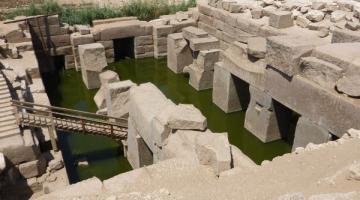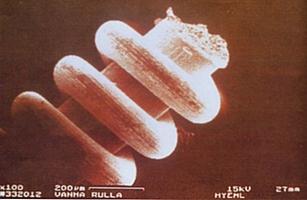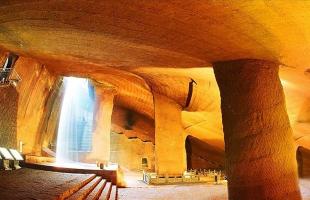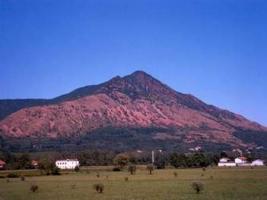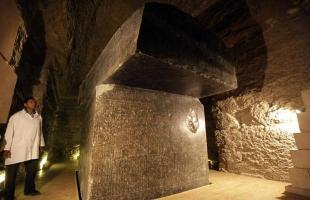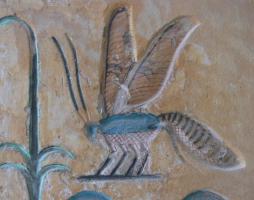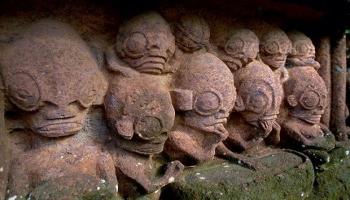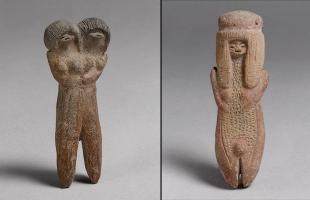The Mokele-mbembe: an unsolved mystery
About 800 kilometers north of Brazzaville, Congo's capital, a vast swamp forest covers approximately 130000 square kilometers. This immense territory is called Likouala. According to legend, at the bottom of the swamp would live a monster called Mokele-mbembe, which translate into "who obstructs the flow of rivers".
A dinosaur among us?
Our expedition did not give us definitive proof, but we gathered new information and, most importantly, the most recent testimony: missionary Paul Ohlin observed the Mokele-mbembe on the Sangha River on January 10, 2006, in northern Congo.
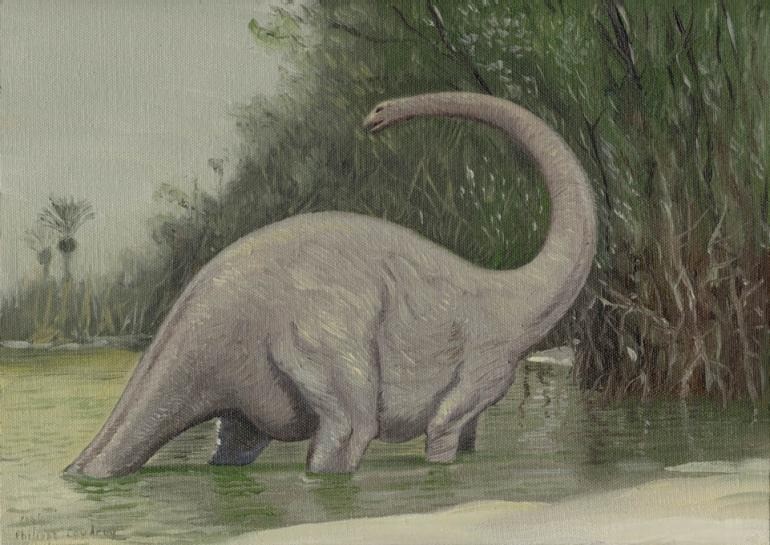
The first Westerner to hear about this monster was, in 1776, the French missionary Lievain Bonaventure Proyart "I know of an animal that must be monstrous...., " he recounts in his memoir, ".... the footprints measure three feet in circumference".
For weeks, the team leaded by Milton Marcy checked a vast area of forest in Africa, a country that is eight times the size of Italy, and collected many tales, especially in the area of the Aka Pygmy Reserve, and traveled up the Sangha River.
We also visited the caves where the monster would live along the bank and made valuable contacts with the people of this area. We convinced several people, especially traders and fishermen living along the rivers, to bring mini-video cameras with them to film the Mokele-mbembe. In return we promised satellite phones for the villages and some fishing boats.
Making the arrangements was complicated in fact, as Mercy explains,
Everyone tries to avoid the animal, because they are afraid of its attacks, but now we are confident that, with the 2007 expedition, we will be able to get a series of unpublished images and prove, once and for all, the existence of a dinosaur-like animal.
But what is known about the expeditions to find the monster and what were the results obtained?
As we have already mentioned, the first Westerner to hear about it was the French missionary Lievain Bonaventure Proyart in 1776.
In 1909, naturalist Carl Hagenbeck wrote in his autobiography "Beasts and Men" that a German named Schomburg and an English hunter had told him about an animal "half elephant and half dragon", living in the swamps of the Congo. Similar reports were gathered by a German army captain, Baron von Stein zu Lausnitz, who was sent to the Congo Basin in 1913. The size would be similar to that of an elephant and the skin would be a grayish-brown color. Other monstrous features are the neck "long and flexible" and the tail "like that of a crocodile".
Here is an interesting part of the German colonial army captain's report:
The general descriptions of the natives all converge on one pattern: the animal is grayish-brown in color and possesses a smooth skin, its size is that of an elephant or at least a hippopotamus. It is said to have a long, flexible neck and only one but very large tooth, some say it is a horn. Some speak of a long, muscular tail similar to that of crocodiles. Canoes that pass through its territory are doomed to sink; the animal attacks boats and kills their crew, but without devouring their bodies. It is said that it lives in caves and climbs the shore in search of food; its diet is entirely vegetable. Its favorite food was shown to me, it was a kind of liana equipped with large white flowers, a milky sap and a fruit similar in shape to an apple.
A number of expeditions were organized during the 1920s, and a new description was elaborated in 1948 by cryptozoologist Ivan T. Sanderston, until, between 1976 and 1980, two missions led by herpetologist james Powell, whose interest in the mysterious animal had been sparked when some natives of Gabon had told him about an aquatic monster, called "N'yamala". Although he had never seen the creature, Powell collected surprisingly concordant first-hand accounts:
The general descriptions of the natives all converge on one pattern: the animal is grayish-brown in color and possesses smooth skin, its size is that of an elephant or at least a hippo. It is said to have a long, flexible neck and only one but very large tooth, some say it is a horn. Some speak of a long, muscular tail similar to that of crocodiles. Canoes that pass through its territory are doomed to sink; the animal attacks boats and kills their crew, but without devouring their bodies. It is said that it lives in caves and climbs the shore in search of food; its diet is entirely vegetable. Its favorite food was shown to me, it was a kind of liana endowed with large white flowers, a milky sap and a fruit similar in shape to an apple.
At the same time a U. S. engineer, Herman Regusters, said he had observed from Lake Tele an animal with an elongated neck and the head of a reptile. At that point the Congolese government sent an expedition entrusted to Brazaville zoologist Marcellin Agnagna: one afternoon, at a distance of less than 250 meters, he saw "a strange animal, which swam for 20 minutes".
Sightings continued in the following years and, in 1992, a Japanese expedition flying over the lake filmed a dark shape, moving rapidly underwater.
The mysterious footprint
This is a photograph of a three-fingerprint, characteristic of dinosaurs....
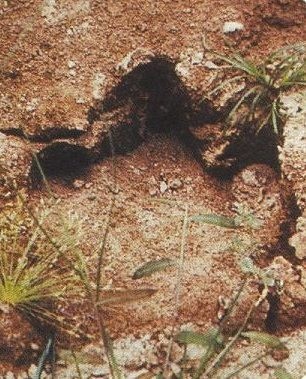
but it could easily be a hippopotamus footprint, since a clod of earth could have hidden the trace of a fourth toe.
The various explanations about the Mokele-mbembe are:
Some persons speculate that the Mokele-mbembe is a turtle from the family of Trionichidae, omnivorous turtles with greatly reduced bone armor and slender necks, or a species of varanus, reptiles that possess a lizard-like body with an elongated head, very long neck, stout but slender trunk and powerful legs.
However, some have also ventured the hypothesis, not entirely impossible, that the Mokele-mbembe is a small sauropod dinosaur such as a Vulcanodon, a 6-meter-long dinosaur found in 1972 in the territories of Zimbabwe by Prof. M. A. Raath, and the description made would be the one that comes closest to the portrait of the Mokele-mbembe.
Conclusions
Reviewing all the data available to us, it does not seem improbable that the heart of the Congo may conceal a yet unknown animal life form Mokele-mbembe continues to elude those who seek it.











